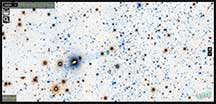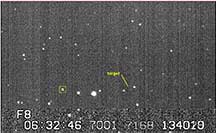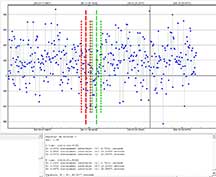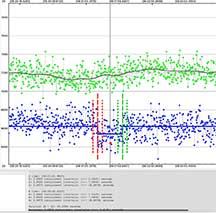The Occultation of a 15.3 Star by the KBO Quaoar
Aug 8, 2022 at 11:31:44pm
This event has very nominal rank. Cabrillo Observatory has a probability of 95.6%. The duration is a high 63 seconds for this slow moving object. We apparently know the orbit of Quaoar pretty well, but it does have a moon - Weywot - which makes astronomers wonder if that makes it more likely there are other moons. Note that Pluto, tiny as it is, has 5 moons. This event is very difficult, however, because the star is very faint and because it occurs only 12 degrees directly above the highly gibbous moon.
My testing with an 8" scope 2 nights before the event, showed that 16x is as high an integration as can be done on the Watec 910hx at manual gain = 41 which is maximum and if using the f/3.3 reducer. 32x is just way too bright a sky to work with. This was even true on the actual field on Aug 6 even though the moon was rather more than 20 degrees away, even though at 16x the sky was definitely darker. Now, I could see the target star at 16x on the 8" 8SE scope but only by using the 'finder' feature in PyMovie to average over the random in time and location speckles of bright sky, by averaging with ~40 frames. That's about 1.33 seconds of time. That's still decent spatial resolution for an event that lasts 63 seconds.
Removing the f/3.3 reducer should help darken the sky and, if seeing is OK, improve the contrast between the star and sky. I am planning to try this from the 12" scope at Cabrillo Observatory, but will have the 8SE scope in my RAV4 ready to deploy if the transformation of the 12" scope away from it's long standing configuration with the ST2000xcm CCD camera, hits a snag somehow. I will be trying it at f/6.3 I expect.
There are 14 observers signed up for this event. I am hoping they realize and plan for the fact we have a big moon very close. It's a LuckyStar coordinated event. They are very confident their prediction is the right one, using recent occultations to refine it. It's got an uncertainty of only 0.08 path widths, and the northern limit is well north of the Bay Area. Santa Cruz is far enough inside their prediction to have very good odds of an event, although our event will probably be only ~44 seconds and not 63 seconds if the Predicted Path from Lucky Star. and now OccultWatcher too, are correct.
As this is a LuckyStar event.... DON'T FORGET TO TAKE A SHORT VIDEO OF DARK AFTER THE EVENT, WITH CAPPING THE WATEC OR THE TELESCOPE. LATER, IN TWILIGHT, GET A FLAT FIELD AND IMMEDIATLY AFTER THE FLAT FOOTAGE, CAP THE SCOPE AGAIN FOR A DARK-FLAT VIDEO LENGTH. Felix Braga advises that the flat field exposure (Watec exposure integration setting) does not need to be the same as for the event. However, the GAMMA and GAIN should be the same. We never adjust GAMMA, leaving it at 1.0. However, the GAIN information is important to know.

LuckyStar prediction map, and the 96% odds of a success for the chord through Santa Cruz. |

This is the Digital Sky Survey image centered on the target. It's much higher magnification than the 8SE charts at right. Because this event happens near the meridian, note that the equatorial chart and the 8SE alt/azimuth chart it oriented very nearly the same - good! |

Q70 eyepiece for the 8" 8SE, as usual, so left-right is reversed. |

LCD chip image in 8SE, with LuckyStar recommended recording length. The orientation here is straight through which happens to match rather closely to the equatorial "north up" orientation of the DSS chart at left. |
|
Results:
Nolthenius (PyOTE log file)
I got to Cabrillo Observatory and fired up the scope and computer and SBIG CCD camera and got it on target. But then, the same annoying "serial port conflict" error started to come up again, freezing the scope. I've already spent hours trying to track down the source of the error, unsuccessful. No time to try that again. Fatal for this situation. I closed it back up, and then to avoid the notoriously poor seeing in the canyon where the Observatory is, drove to the upper Marshall Meadow at UCSC and got a good recording from there. I removed the f/3.3 reducer and this darkened the sky considerably compared to the stars. Seeing was good and stable, so they stayed sharp and the sky dark, and this allowed going to 32x integrations, with the 15.3 mag target now faintly occasionally visible on some of the live frames. I taped from about 8 minutes before, to 15 minutes after the occultation.
I used the 5.3 pixel default aperture, which PyMovie chose to use for every single frame. 2-sigma threshold, and box size of 21 pixels, which insured that the two 13th mag stars would not be in the target box at any time. I used two moderately bright tracking stars and one empty 'sky' aperture. The static aperture on the target tracked the target position well. However, at this high magnification, tracking errors in the telescope drive required several paddle adjustments and even at the slowest (motor speed=5) Celestron setting, PyMovie was not able to keep up with the tracking stars during these scope pointing moves. So, reduction of my data for the wings of this event, looking for other satellites, will be more tedious for LuckyStar astronomers to do, alas. For 2-star alignment I used Polaris and Nunki, very well separated, and the result was a spot-on Go-To the target, but the periodic error and slack in the gears meant some wandering. This required a few re-positionings and will require adding in the post-6:35UT segments manually later, by LuckyStar. Tracking usually not a problem when using the f/3.3 reducer, but for a 30 minute integration here at higher f/10 and smaller chip field, it caused wandering that required live repositioning. I broke the video into two 2.52 GB segments, with 6:35:20 UT as the time for ending one and starting another. Fortunately, the first section is long enough to entirely and easily encompass the event and without any tracking trouble. PyMovie could analyze it without error. Why did I break the 30 minutes into smaller pieces? The reason was the FAT32 file structure of my thumb drive, and also worry about transferring big files to LuckyStar. I overlapped these two 2.52GB videos by about 8 seconds so no actual data coverage is lost. Below, you'll see only the pre-6:35:20 segment, which includes the actual occultation. If anyone finds a secondary occultation and my video in the 2nd segment is of use, Lucky Star now has both of my videos.
I submitted my .avi videos, and associated "dark video" right after the event, and also a flat field + dark-flat immediately after the twilight flat. So, 2 video segments for the event itself, and 1 dark for the event, and then 2 more videos for the flat and it's associated dark video. 5 videos in total. The darks and flat were zipped together into a single .zip file before sending to LuckyStar. I also filled out the required informational boxes on the LuckyStar Occultation Portal.

By making a long series of 'finders' and adjusting the brightness/contrast slider to be at 140 and 70, I could optimize the visibility of the faint target star. The 1-second finders combine two different integrations, but the results are not as clear as if I combined 3 seconds of data (96 frames) per finder. This image was a minute after the occultation. |

Green points are the target, which are barely above sky. |

The seeing was good, altitude 31 degrees due south, and no wind. Except for the moon, conditions were near ideal. |

PyMovie photometry of each frame for the target. There's clear up/down/up/down noise which can be even'd out by combining adjacent integrations, so that's what I chose in PyOTE, with 'manual integration' option |
|
PyOTE Reductions: Given the fainter 16 or 17th mag stars on the DSS image that would be in the PyMovie aperture, I decided it might give better statistics to not do a sky background subtraction, which might be adding in light from errant stars to the 'sky' background and thus degrading the signal to noise. This turned out to be true. Instead I used the 'appsum' setting and this lead to a '0 chance of false positive'. I also realized that with the good predictions agreement now between OW and LuckyStar, that there was some confidence that our event was not very short. In fact, with the nominal OW predictions, the predicted duration for my event was 44 seconds out of a maximum possible of 63 seconds. The target is barely above sky, but it seems clear that the D and R were somewhere within the D and R regions I chose, and shown in the PyOTE image below. This gave a '0 chance of false positive', and a duration of 33.5 seconds which turned out to be exactly centered on the predicted center time of the event: 6:31:44 UT. The PyOTE determined 2-sigma duration error of 12.5 seconds could take that duration on up to 45 second duration.
This is the solution I have submitted to Lucky Star, and then on Aug 15, submitted to IOTA along with the IOTA report form.

This choice of parameters gave a good solution.
|

These are the D and R regions I told PyOTE to search with. |

The Solution times and accuracies are below the plot. |

The solution plot, zoomed in. |
|
For an earlier solution attempt, I did the normal procedure of subtracting the sky background to get the star magnitude (PyOTE menu choice = "signal" under MISC) method. Davd Herald and I already discovered and discussed a month or so ago, on my Erida event in June, how, in a crowded Milky Way field with a very faint target, that this could not just fail to improve the signal, but actually significantly detract from it because sky counts 'background' is SUBTRACTED from the 'appsum' (aperture sum of pixel values for the target), and so make for worse noise than ignoring the background. The cost of using the 'appsum' method is that you don't get to see what the magnitude depth is, but that's not of prime importance here. Quaoar itself is 19th magnitude and invisible, it's a "full disappearance". Anyway, that solution with the 'signal' flag set, does give a worse solution. It's worse in several ways. The occultation duration is 24 seconds - significantly shorter than is likely. And the center of the occultation is then 5 seconds early. Since Quaoar is occultation-determined to be 700 miles across, it's likely to have significant gravity and be pretty spherical. And, it fails the "0 chance of false positive" test, although not horribly. The D time agrees with the favored solution, but the R time is 9 seconds earlier.

The formal 'false positive' test failed by a bit, however, this range of data was confined to the interval between scope position adjustments (which caused PyMovie to lose acquisition of tracking stars). A total of 30 minutes of data was taken however, so that if those other segments could be added to this more limited data (6:28:13 to 6:35:20 UT) light curve, it would make sense that the false-positive test would be better and perhaps "pass". |

The data is definitely almost lost in the weeds. 15.3 is a full magnitude dimmer than any other event I've tried on an 8" scope.
Note that this "solution" came from my subjective setting of the D and R ranges. Noisy data likely had me setting the R point too far to the left. |

Zoomed in. The timings and accuracies are shown below the light curve.
|
 |
|
What lessons did I learn?
1. In crowded Milky Way fields, try using the 'appsum' setting in PyOTE and see if it improves the solution.
2. Don't be afraid to manually set a longer interval for an integration point in PyOTE. You may be limited by sky brightness to a lower integration than would be preferred. In this case, get your integration as a better "average" manually in PyOTE. This may hurt the "0 false positive test" if the event is too short to get a good number of occulted readings, however.
3. Dimmer stars than might be imagined possible, can be done if the conditions (like atmospheric stability) are good enough. Dark skies would be even more so.
4. In crowded star fields with faint targets, don't be afraid to pull off the f/3.3 reducer if the seeing is good. You then must crank the focuser clockwise by about 20 comfortable normal turns of your hand (that'll be about 10-13 full revolutions) from the normal focus point with the f/3.3 attached.
This event will be a very good example of using the 'finder' technique to get more confident identifications of occultations, in an IOTA Presentation I'm preparing and will link here when ready.
Kirk Bender (Pyote Log file)
Kirk observed with identical equipment, and a less noisy Watec camera, from the Bonny Doon Ecological Preserve. He used the f/3.3 reducer and 16x setting on the Watec. He got a recording, and comparing his data with mine will be interesting as far as S/N. Removing the f/3.3 reducer is clearly the best strategy in crowded star fields with faint targets and bright skylight. Nevertheless, his less noisy camera more than compensated, and his light curve below looks good, and has slightly better timing accuracies as well. The variations in the light of the tracking/reference star are clearly significant, but not large, if you look at the absolute numbers. The sky was clean. Kirk says the wavy pattern was strongly correlated with the wandering of the tracking. Perhaps the focus sharpness with the f/3.3 was dependent enough on it being on-axis? The cause of the wavy photometry is not clear to me.
Kirk reported his observations to LuckyStar and to IOTA on Aug 15, 2022.
















